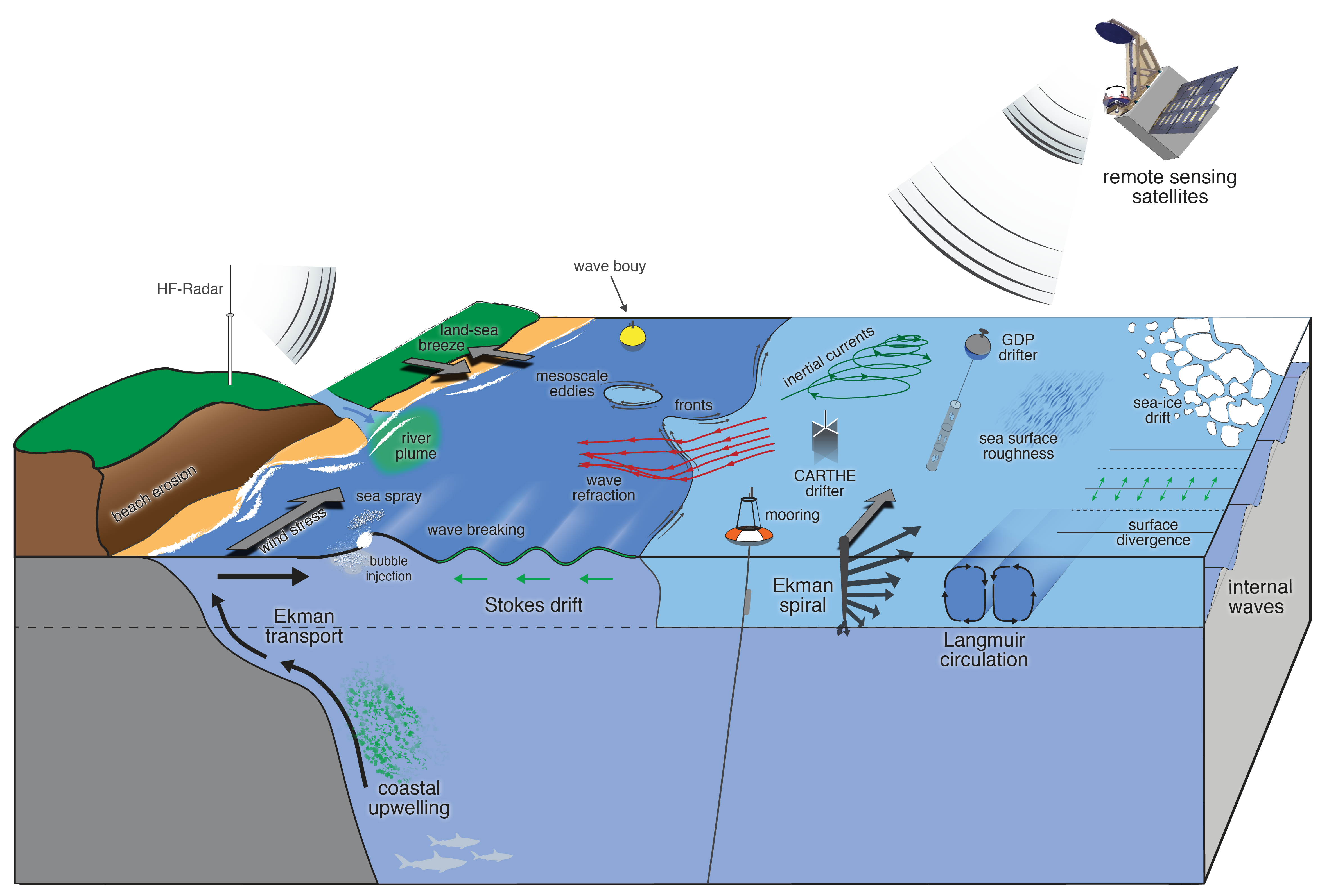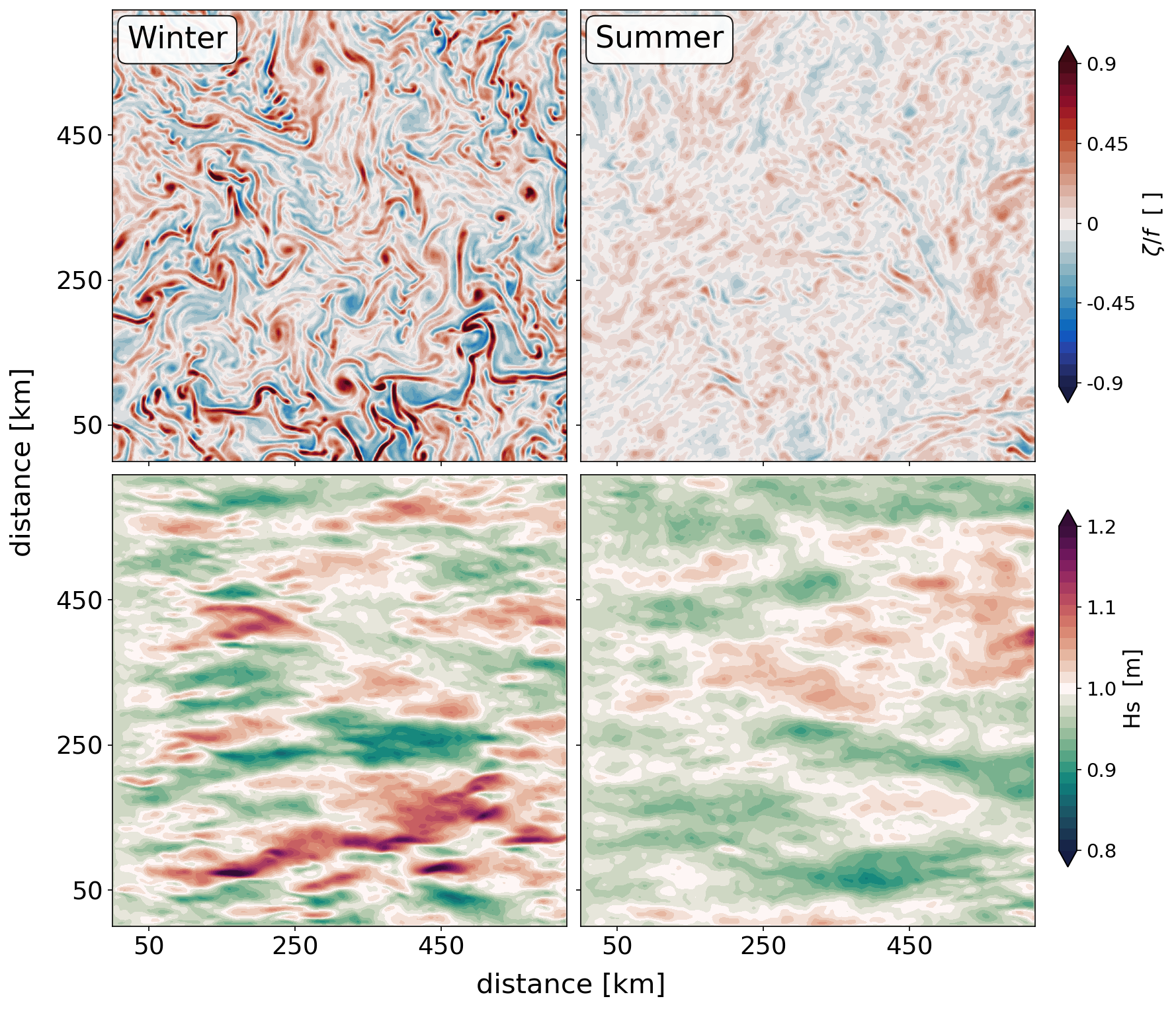Research

The broad goals of my research are aimed at combining observations, theory, and modeling to help bridge the gap between the ocean and the atmosphere and further our understanding of how coupled air-sea interactions affect the environment. My vision is that progress in the area of air-sea interactions calls for joint high-resolution observations of winds, currents, and waves. In 2019, I led an Oceanobs community paper with over 20 colleagues that share this vision. I am currently involved with the science teams of the Surface Water and Ocean Topography (SWOT) mission and NASA's Sub-Mesoscale Ocean Dynamics Experiment (S-MODE), which will be both of paramount importance to improving our understanding of upper-ocean dynamics.
Wave-Current interations
I am interested in understanding how surface waves respond to currents. Here, the central idea is that currents modify the wave field, so the goal is to look for relationships that would allow us to infer properties of the currents based on the wave response. Together with Bill Young, I used a multiple-scale expansion approach to average the wave action balance equation over an ensemble of surface currents. We show that the potential (irrotational) component of the surface velocity field has no effect on the diffusivity of wave action: only the vortical component of the surface velocity results in diffusion of surface wave action. These simple yet powerful results were published in the Journal of Fluid Mechanics in early 2020.

I have also approached wave-current interactions using numerical wave and ocean models. In Villas Bôas et al. (2020), I used large ensembles of stochastic currents to force WAVEWATCH III and assess the relative impact of current divergence and vorticity in modifying several properties of the waves, including direction, period, directional spreading, and significant wave height. We show that the spatial variability of the significant wave height is driven by the rotational component of the flow. An important takeaway from this work is that gradients of wave quantities contain information about statistical and kinematic properties of the flow. In addition to the synthetic current forcing, a set of idealized simulations with realistic currents from the MITgcm llc4320 model revealed a highly structured wave response to coherent features present in the llc4320 currents, offering the possibility of using wave parameters to detect and characterize gradients in the velocity field. The analyses from Villas Bôas et al. (2020) can be fully reproduced using the model output and the source code.
Wind effects on waves

The surface wave field in a given region is set by the combination of local and remote forcing. In the California Current region, regional-scale wind events known as expansion fan winds are the dominant forcing for waves off the California coast in spring and summer, leading to relatively short-period waves (8–10 s) that come predominantly from the north-northwest. In Villas Bôas et al. (2017), we characterized the intra-annual variability of the surface wave field in the California Current region focusing on the contributions of local versus remote forcing. We built a thorough climatology that showed that the average significant wave height in the region exceeds 2 m during most of the year, which have implications for the planning and retrieval methods of the Surface Water and Ocean Topography (SWOT) satellite mission. The results from Villas Bôas et al. (2017) have been used to guide the calibration and validation efforts for SWOT as well as the planning of NASA’s Submesoscale Ocean Dynamics Experiment (S-MODE). The source code for this project is available here.
Air-sea heat fluxes at mesoscales

Remote sensing satellites have transformed our ability to observe the Earth, allowing us to measure environmental variables at global scales. In the past decade, improved temporal and spatial resolution of satellite altimeters, radiometers, and scatterometers provided observational evidence that while the atmosphere generally forces the ocean at large scales, oceanic meso and submesoscales features have the potential to force the atmosphere. Combining over 10 years of remotely sensed surface turbulent heat fluxes with satellite altimetry data, I investigated the impact of oceanic mesoscale eddies on the latent and sensible heat fluxes in the South Atlantic Ocean. Together with my collaborators, I found that the heat flux anomalies related to eddies explain up to 20% of the total variance in the surface turbulent heat fluxes in that region. Our results suggested that these anomalies could be strong enough to impact beyond the boundary layer, and thus they could affect the large–scale atmospheric circulation. Since the publishing of Villas Bôas et al. (2015), a series of studies have confirmed that heat flux anomalies due to ocean eddies can induce a non-local response and impact the atmospheric circulation far from eddy-rich regions.
